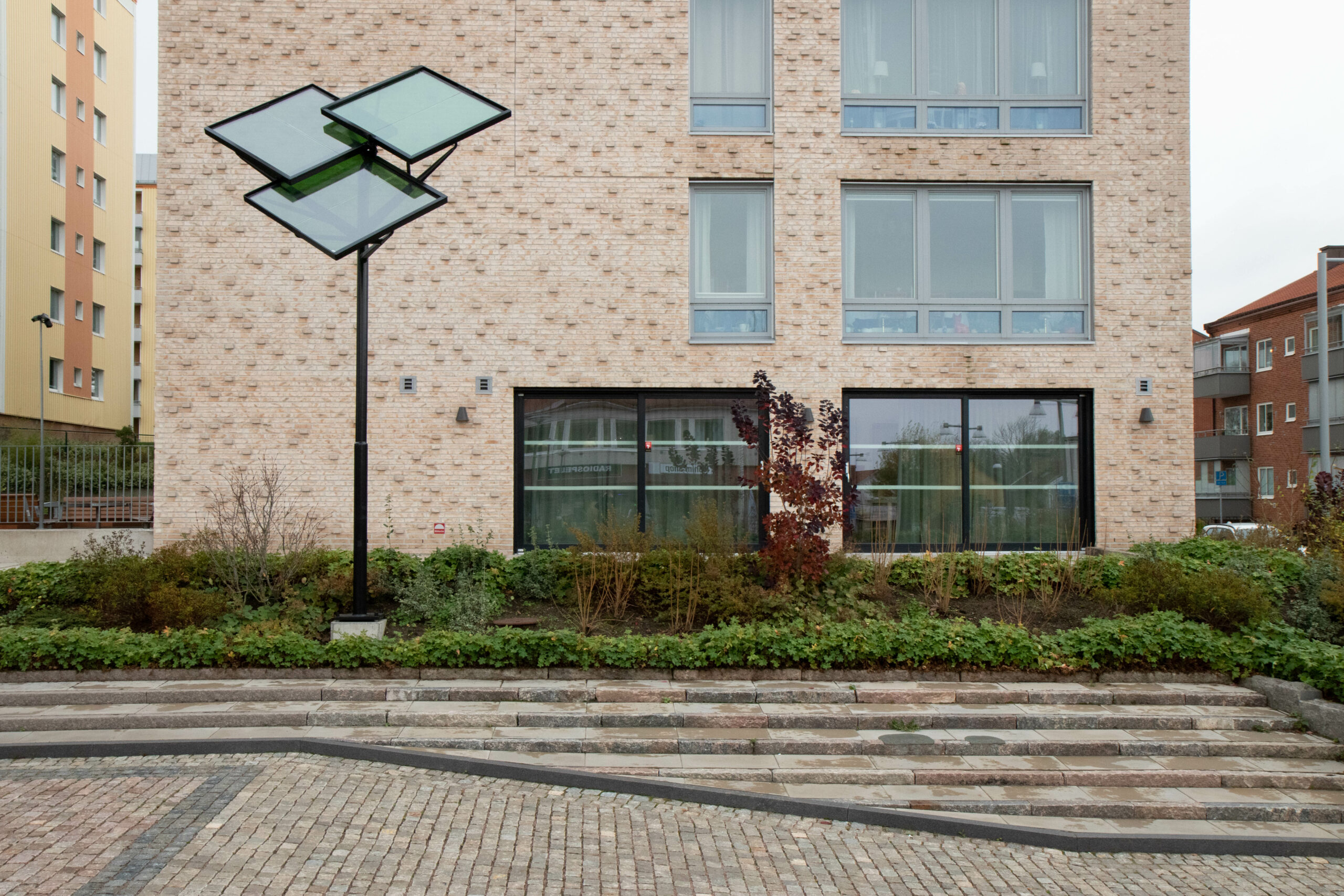
Time Circuit consists of two heated bronze seat marks integrated into the staircase facing Radiotorget, and a sculpture with solar cells that heats the seat marks. The seat marks were left by two residents of Radiotorget: a 95-year-old who has lived there since it was built in the 1950s, and a 10-year-old child who had just moved into one of the houses next to the square when the artwork was created. If you sit on a mark, you can be warmed by it and become part of a circuit through time and space, through the energy of the sun as well as those who left their mark.
Art Consultant: Marie Holmgren. Commissioner: Göteborg Konst
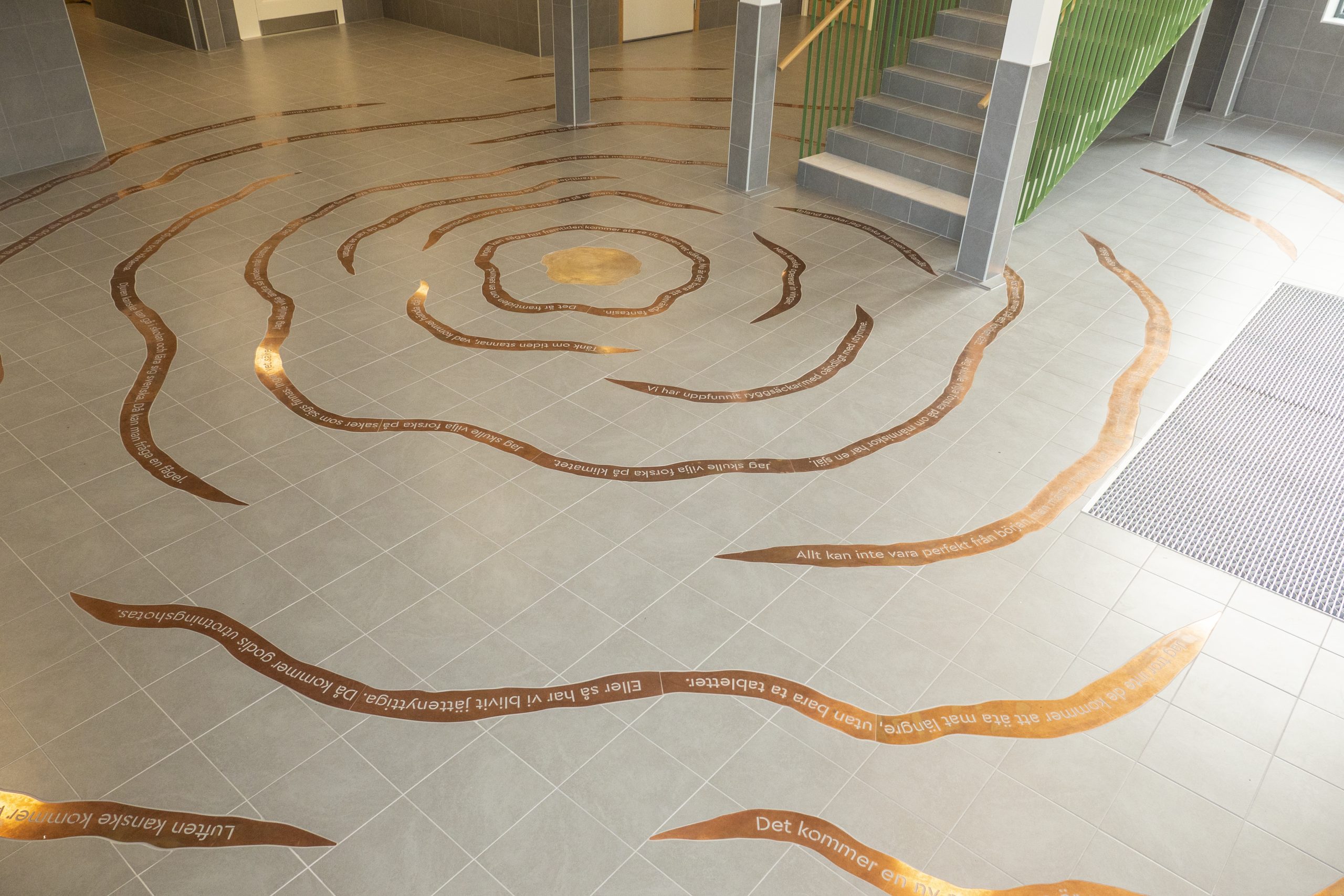
The work Growing Futures came about through a collaboration between My Lindh and fourth and fifth graders in Tallbacken’s school. The work consists of annual rings in bronze that spread out over the school’s entrance floor. The annual rings contain sentences with the children’s thoughts about time and the future. In the middle of the floor is a bronze plate, made after the largest pine that grew on the site before the new school was built. When My counted the annual rings, she concluded that the tree must have been growing on the site since around 1830. When the children now enter their new school building, they are literally stepping into their history, their present and their future.
Curator: Björn Norberg. Commissioner: Gävle municipality/Gävle konstcentrum.
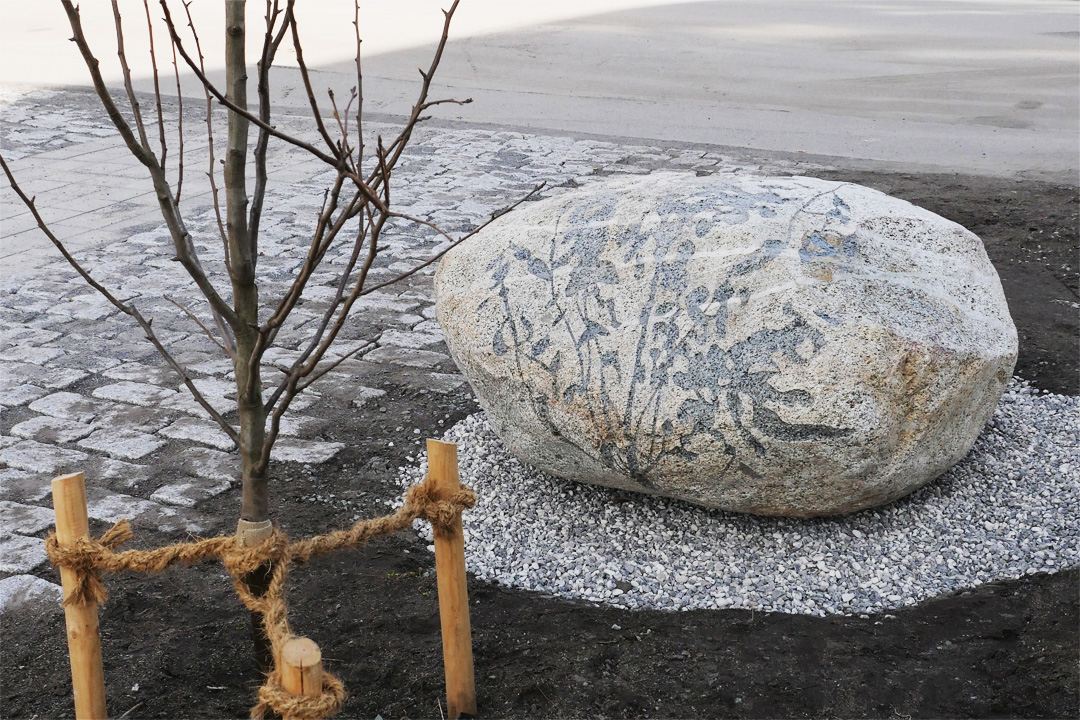
The Sun Mountain is a commissioned work for Solberga outside of Stockholm. The commission came about after my work with the public commission Time to stay which was made in the same area. The Sun Mountain consists in a big stone and a pear-tree. The shadow of the pear-tree has been sandblasted into the surface of the stone. The stone was found and saved when new houses in the area of Solberga were built.
Commissioner: Konstnärscentrum öst
Art consultant: Birgitta Silfverhielm

Nine site-specific sentences have been sandblasted into the built environment at various locations in the residential area Vallastaden, Linköping. The sentences address people moving in the area, while walking on the sidewalk, crossing a corner or looking over a railing. The main character in the texts is the reader themselves in relation to their own posture, the surrounding nature and the bypassing moment.
Pictured sentences:
my curiosity | around the next corner | led me further
I moved closer to the maple | in the direction of the text | towards City Gross | Kaliningrad | Damascus
there | against the wall | I had to bend down | to read on
I could have stepped on them | but read the words | neck facing the sky
if the light were to fall against the letters | my shadow on the ground | underneath would be darkness, roots, earth
Commissioned by the municipality of Linköping for Vallastaden
Art consultant: Åsa-Viktoria Wihlborg for ArtPlatform
Special thanks to: Khashayar Naderehvandi and Rikard Heberling
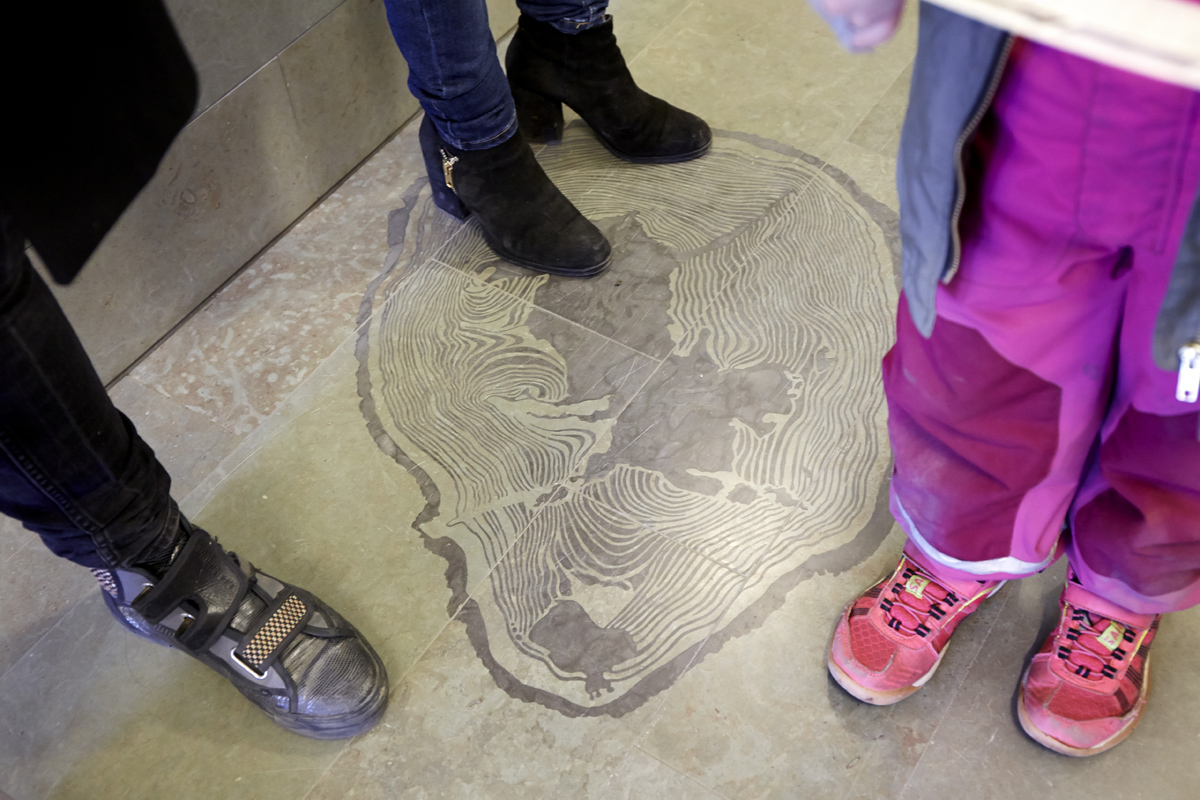
Time to stay is a commissioned work for Rubinvägen outside of Stockholm. The work relates to the changing cityscape and population by discussing time, circulation and traces. The work consists in three parts: Then, Now and Soon. The oak is a central element in all three parts. The work was conducted in collaboration with residents in the area and actively involves the residents aswell as the visitors of the area through their everyday movements.
Then is a number of marks after the bigger trees that grew around Rubinvägen before new houses were built in the area. The annual rings after each tree has been sandblasted into the limestone of the new houses’ entrance halls. On new walking paths the circumference of the trees have been marked through carriage bolts hammered into the asphalt.
Now are seating marks in park benches. The residents in the area have contributed to the work by leaving their seating marks. 14 of these have been cut out in oak and made as intarsia into the pinewood benches. The wood of the benches has been impregnated with an organic method which make the wood age naturally.
Soon is a big oak that has been planted in the area. Some big trees were taken down when the new houses in the area were built. I saved oak corns from the area and let them grow to plants. At the inauguration of the work, the residents were invited to make a common planting of 12 of the plants, in order to let a new oak grow in the area. An oak is said to grow for 300 years, live for 300 years and die for 300 years.
Commissioner: Konstnärscentrum öst and Stockholm Konst
Art consultant: Birgitta Silfverhielm
Special thanks to all the residents who contributed with their seating marks

Postcards from Gränby was a site-specific, temporary installation commissioned by Uppsala municipality in Sweden. The work consisted in five signs placed in the nature surrounding a big shopping mall. Just next to the shopping mall are fields and pastures and one of Swedens oldest churches. At the time of the installation, the area was undergoing major change – there were plans for a new residential area, an arena and more.
Postcards from Gränby, which is the name of the piece, want to get your eyes to slow down and see the process underway in the area, which is under heavy development and commercialisation of a rate that might not only make us charmed by the desire to buy and hope for the future. Himmel och fält / Sky and field notes laconically a subtitle in front of, well, a sky and a field. Natur / Nature it says in front of a grove. Kulturbygd / Cultural heritage recites a banner in front of Vaksala Church, which during its nearly 1,000-year of age during a justifiable time has been an obvious focal point in the landscape. The flashy shopping centre that the big mall constitutes, you might say, has stolen the historic building’s position on the plain. Or inherited. The old stone body from the 1100s is of course, if you choose this perspective, part of the same human movement, the domestic annexation, as Gränby Centre is.
—Sebastian Johans, excerpt from a review in Uppsala Nya Tidning, 2016
Postcards from Gränby is produced with support from Uppsala Municipality and is part of the Uppsala Municipality Art Collection.
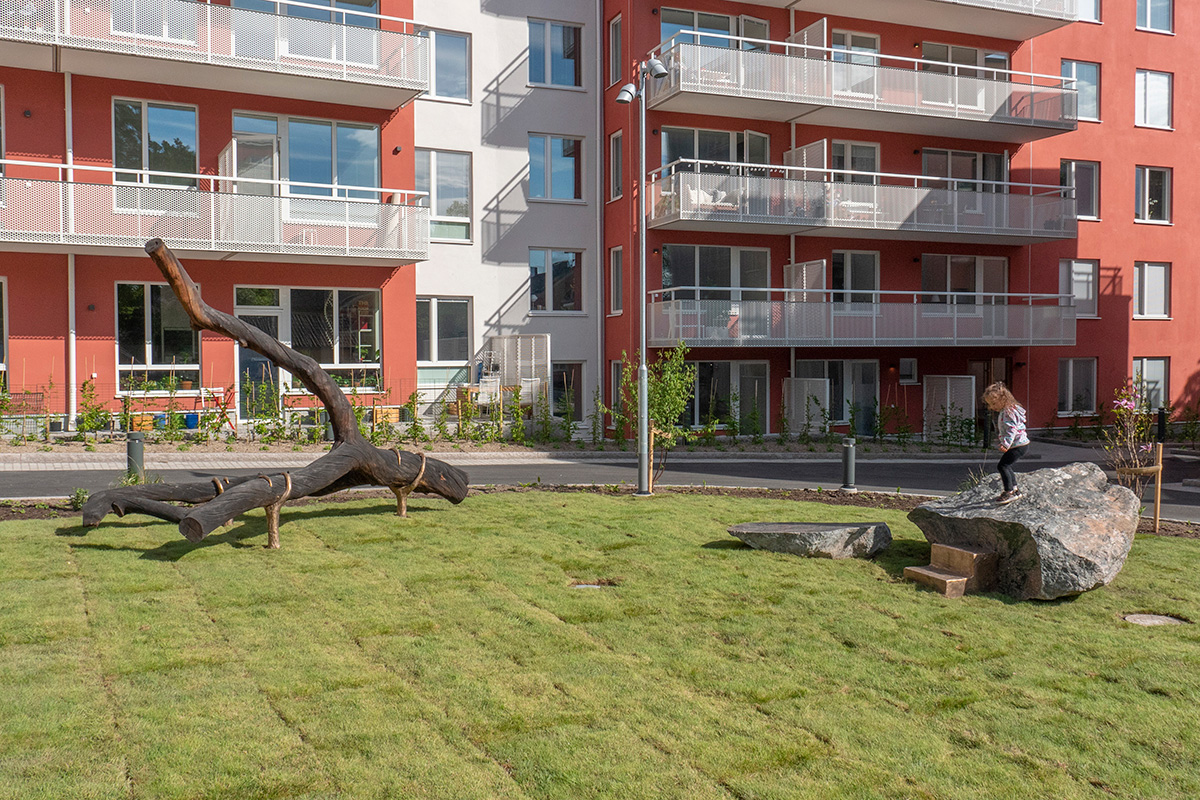
Selected parts deals with the past, present and future. At the site, there was previously a rock and a cherry tree. A piece of the rock has been brought back to the site and split in two. A bronze staircase has been set adjacent to it. The surface that appears in the cut of the stone, reveals a space that testifies to the creation of the stone. A piece of the cherry tree has also been brought back and is now elevated with enclosing bronze bars. The work invites residents and passersby to play with and sit on the art. Over time, the bronze oxidizes and, where worn, traces of human activity appear.
Commissioned by HSB Stockholm
Art consultant: Åsa-Viktoria Wihlborg for ArtPlatform






